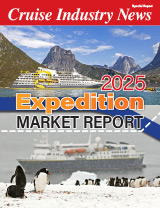 Northwest Pacific ports offer unique attractions on cruises to Alaska and British Columbia and are also setting new standards with a clean air strategy.
Northwest Pacific ports offer unique attractions on cruises to Alaska and British Columbia and are also setting new standards with a clean air strategy.
Vancouver: How to Grow the Market
“To grow Alaska further, the industry needs better utilization on other days (than the popular days),” said Greg Wirtz, manager of trade development at the Vancouver Port Authority. “We also need new ports of call, and remember there are only two homeports – Vancouver and Seattle – compared to all the ports that serve the Caribbean, for instance. And there are only three main ports of call,” he added, “Skagway, Juneau and Ketchikan.
“What we need to grow the business in Alaska is a more diversified product. New ports such as Icy Strait, Prince Rupert, Campbell River and Nanaimo help.”
Meanwhile, Vancouver’s Alaska business is solid with some 900,000 passengers projected for 2008, “within 10 percent of 2007 – down a little with one less ship from Celebrity,” according to Wirtz. Last year’s passenger count was approximately 960,000.
Seattle: Clean Air Strategy
Seattle is projecting 208 calls and 828,000 passengers for 2008, up six percent from 2007, which Mike McLaughlin, cruise services manager, described as a very successful year with 190 calls and 781,143 passengers. That was a 4 percent increase over 2006.
Seattle expects to start construction on its new terminal 91 this year and Holland America and Princess will move to the new terminal. They are presently using Terminal 30 which will be converted back to container traffic.
The new terminal will be 143,000 square feet with two levels and able to accommodate up to Voyager- and Grand Princess-class ships, McLaughlin said.
Ships calling in Seattle are required to plug into shoreside power or burn low sulfur fuel while in port to minimize emissions.
“We are working with all the sectors of the maritime industry to minimize emissions,” said McLaughlin, “and the cruise ships are the forefront of the effort.”
Having joined forces with Tacoma and Vancouver, the three ports aim to reduce particulate matter from ships at berth by 70 percent and 30 percent from cargo handling equipment by 2010.
The key to success is to focus on the passenger experience. “We model our operating procedures around the passenger experience,” said McLaughlin.
Prince Rupert: Record Year
“We had a record year in 2007,” said Shaun Stevenson, vice president of marketing and business development at Prince Rupert.
With more than 100,000 passengers last year, Prince Rupert has seen steady growth over the past four years.
Stevenson pointed out that Prince Rupert is only 65 miles south of Ketchikan.
But while Ketchikan can be crowded with ships and passengers, a ship calling in Prince Rupert are usually the only one in town, thus providing a better experience, Stevenson added.
“We are surrounded by wilderness, and there is a grizzle bear reserve just north of us.
Prince Rupert also has a rich aboriginal history, according to Stevenson, who said that 40 percent of the area population is of aboriginal origins. And, that there is a variety of archeological sites.
“We can compete with Alaska and offer a comparable and even better experience,” he added. “We are a one-ship-at-a-time port.”
Prince Rupert is also part of the Cruise BC group, promoting cruises in the British Columbia region, which Stevenson said is synonymous with the Inside Passage.
Excerpted from the Cruise Industry News Quarterly: Winter 2007/2008



